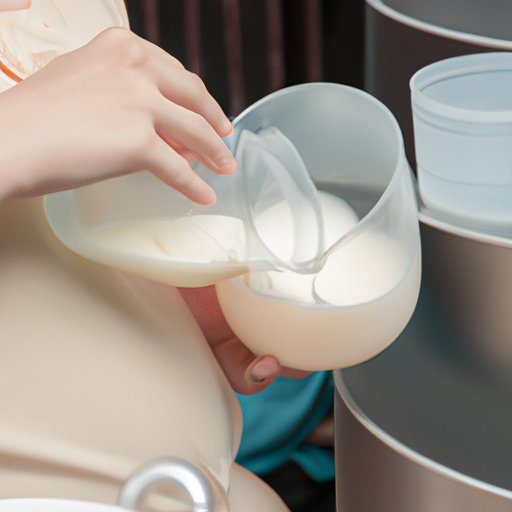
Introduction
Power pumping is an intensive pumping technique that can help breastfeeding mothers increase milk production. It involves pumping for short intervals and taking breaks, replicating the pattern of a baby who feeds frequently. In this article, we will discuss what power pumping is, why it may be necessary, and the benefits of power pumping.
A. Definition of Power Pumping
Power pumping refers to an intense pumping session that involves pumping for short periods of time, taking breaks, and repeating the process multiple times. The aim of power pumping is to increase milk production by mimicking the frequent feeding pattern of a newborn infant.
B. Explanation of Why Power Pumping May Be Necessary
Several factors can lead to a decrease in milk production in nursing mothers. Stress, poor diet, inadequate breastfeeding techniques, and certain medications can impact milk supply. When a baby is unable to get enough milk during breastfeeding, they may become fussy and unhappy, leading to frustration for both mother and baby.
C. Overview of the Benefits of Power Pumping
Power pumping can help increase milk production, build a freezer stash of milk, and prepare for a shorter interval between feedings. Additionally, power pumping can help nursing mothers maintain their milk production while travelling or returning to work after maternity leave.

II. The Benefits of Power Pumping
A. Increased Milk Production
Power pumping can help increase milk production by stimulating milk-producing hormones. By replicating the frequent feeding pattern of a newborn, the mother keeps the milk flowing. Over time, the body recognizes the increased demand for milk and produces more milk to meet the baby’s needs.
B. Building a Freezer Stash
Power pumping can help nursing mothers build up a freezer stash of milk that can be stored for future use. This is especially useful when the mother returns to work or when someone else takes care of the baby. The stored milk can be thawed and used when necessary, providing a consistent supply of milk for the baby.
C. Prepping for Shorter Feeding Intervals
Nursing mothers who power pump are preparing their bodies to handle shorter feeding intervals. Power pumping stimulates the production of milk-producing hormones, allowing the mother to produce enough milk to satisfy the baby’s hunger throughout the day.
III. The Mechanics of Power Pumping
A. Explanation of the Difference Between Power Pumping and Regular Pumping
Power pumping differs from regular pumping in that it involves shorter pumping sessions and more frequent breaks. Instead of the usual 20-30 minutes of pumping, the power pumping session may last 10-15 minutes, followed by a break. This process is repeated several times over one hour.
B. The Science Behind Power Pumping
Power pumping is based on the physiological principle of supply and demand. The greater the demand for breast milk, the more the body produces. Power pumping signals to the body that it needs to increase milk production to fulfill the baby’s needs.
C. Overview of How it Works
Power pumping involves pumping milk for ten to fifteen minutes, taking a short break, and repeating this process for up to one hour. This pattern stimulates an increase in milk production, allowing the mother to produce more milk in a shorter period.
IV. Basic Power Pumping Routine
A. Step-by-Step Guide to a Basic Power Pumping Routine
The basic power pumping routine involves pumping for ten to fifteen minutes, taking a break, and repeating the process several times over one hour.
B. How Long to Pump, When to Take Breaks, and How Many Times to Repeat the Process
It is recommended to pump for at least one hour, divided into several segments. Each segment should last for ten to fifteen minutes, followed by a break of ten minutes. This process should be repeated three to four times.
C. How to Maintain a Consistent Schedule
Setting a consistent pumping schedule can help maintain milk production. Power pumping should be done two to three times a day, after breastfeeding or between breastfeeding sessions. It is important to follow a schedule to allow the body to adjust to the increased demand for milk production.
V. Power Pumping with a Purpose
A. Reasons Why a Mom Might Choose to Power Pump
Some reasons why a mom might choose to power pump include: low milk supply, working away from the baby, preparing for a growth spurt, or building a freezer stash. Power pumping can also be useful when a baby is not feeding well or is unable to breastfeed because of medical issues.
B. How to Set Goals and Measure Success
Setting realistic goals and measuring success can help keep a breastfeeding mother motivated. Goals can include pumping for longer periods, achieving greater milk output, or building a freezer stash. Success can be measured by keeping a log of milk output and charting progress towards goals.
C. How to Stay Motivated
Staying motivated while power pumping can be a challenge, especially when milk output is low. Avoid focusing solely on the amount of milk produced and concentrate instead on the process. Taking breaks, relaxing, and listening to music or reading can help maintain motivation. Joining a breastfeeding support group can also provide encouragement and support.
VI. Customizing Power Pumping to Individual Needs
A. Using Different Pump Settings
Using different pump settings can help customize power pumping to individual needs. Experimenting with pump suction and speed can help find the most comfortable and efficient setting.
B. Pumping More Frequently During Certain Periods of the Day
Pumping more frequently during times when milk supply is low can help increase production. It is recommended to pump at least every two to three hours, especially during the night when milk-producing hormones are at their highest.
C. Tailoring the Routine to Suit Individual Goals
Power pumping routines can be tailored to suit individual goals, including building a freezer stash, increasing milk production, or preparing for a shorter feeding interval. Setting achievable goals and tracking progress can help achieve desired outcomes.
VII. Combining Power Pumping with Other Techniques
A. Nursing on Demand
Combining power pumping with nursing on demand can help increase milk production. Nursing on demand signals to the body that more milk is required, stimulating the production of milk-producing hormones.
B. Using a Lactation Consultant
A lactation consultant can provide support and advice on breastfeeding techniques, positioning, and latch. Lactation consultants can also provide information on power pumping techniques and routines.
C. Taking Certain Supplements
Taking certain supplements, such as fenugreek, can help increase milk production. Consulting with a healthcare provider before taking supplements is recommended.
D. Exercise and Diet
Regular exercise and a balanced diet can help improve overall health and well-being, positively influencing milk production. Consuming foods rich in lactogenic properties, such as oats and flaxseed, can also help increase milk production.
VIII. Troubleshooting Common Power Pumping Issues
A. Dealing with Discomfort
Discomfort while power pumping is common. Ensuring a proper fit, using a lubricant, and adjusting pump settings can help reduce discomfort.
B. Adjusting Pump Settings
Experimenting with different pump settings can help find the most comfortable and efficient setting. It is recommended to start with low suction and gradually increase the suction level.
C. Maintaining Motivation
Maintaining motivation while power pumping can be a challenge. Staying hydrated, taking breaks, and using relaxation techniques, such as deep breathing, can help maintain motivation.
D. Ensuring Proper Output
Ensuring proper milk output can be achieved by using the correct pump settings, starting with low suction, and gradually increasing suction levels. Massaging the breast before and during pumping can also help achieve a higher milk output.
IX. Conclusion
A. Recap of the Benefits of Power Pumping
Power pumping can help increase milk production, build a freezer stash, and prepare for a shorter interval between feedings. Customizing power pumping to individual needs can help achieve desired outcomes.
B. Review of the Key Takeaways from the Article
In this article, we discussed what power pumping is, why it may be necessary, and the benefits of power pumping. We also discussed the mechanics of power pumping, a basic power pumping routine, customizing power pumping to individual needs, combining power pumping with other techniques, and troubleshooting common power pumping issues.
C. Encouragement to Readers to Try Power Pumping and Seek Help When Needed
Power pumping can be an effective way to increase milk production and build a freezer stash. It is important to remember to stay motivated and seek help when needed. A healthcare provider or lactation consultant can provide support and advice on power pumping techniques and routines.





